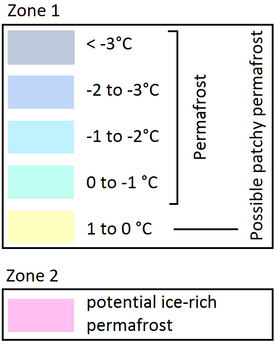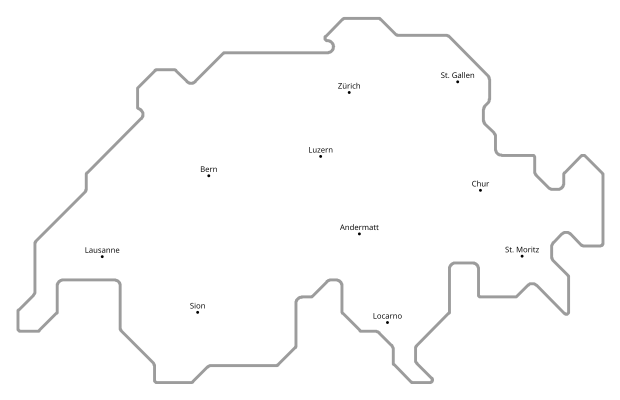Permafrost is an invisible thermal phenomenon, which has a significant influence on the stability of construction substrates or steep rock walls. Knowledge about the distribution of permafrost is particularly useful for planning mountain infrastructure or determining potential natural hazards.

The new permafrost and ground ice map (PGIM) developed by SLF helps evaluate local and regional permafrost distribution. The mapping method used distinguishes between ice-rich and ice-poor permafrost for the first time. Ice-rich permafrost consists of permanently frozen sediments whose ice content exceeds the pore volume. This includes features such as rock glaciers or ice-rich talus slopes, which often contain layers of ice several metres thick. The remaining permafrost is mapped as being ice-poor and includes permafrost in rock walls or in dry talus slopes.
Zone 1: ice-poor permafrost
The mean annual temperature of ice-poor permafrost is mainly driven by elevation and aspect. It is therefore possible to estimate its temperature, as well as its spatial distribution. This information is shown in Zone 1 of the PGIM, where negative ground temperatures are mapped in blue colours and a transition zone between 0°C and +1°C is shown in yellow.
Zone 2: ice-rich permafrost
Ice-rich permafrost often forms through ice sedimentation, for example from avalanche deposits or remains of glaciers, which are covered with rock debris. Ice-rich permafrost is therefore mainly found in areas where such processes occur, i.e. at the base of slopes. Large amounts of energy are necessary to warm or melt the ice in ice-rich permafrost. This is due to the physical properties of ice, which has a high heat capacity. It explains why ice-rich permafrost can occur at much lower elevations and in warmer areas than ice-poor permafrost. The ice content therefore determines whether permafrost is present or not. Ice-rich permafrost can exist under highly variable climatic conditions.
The deformation of ice-rich ground (e.g. in rock glaciers) also influences the distribution of ice-rich permafrost. Mapping ice-rich permafrost is therefore more challenging than mapping ice-poor permafrost. Zone 2 of the PGIM therefore includes all areas in which the occurrence of ice-rich permafrost is possible (pink areas). It can also contain permafrost-free areas. In addition, ice-rich permafrost was only mapped outside Zone 1, implying that the map only shows ice-rich permafrost located below the zone of ice-poor permafrost. The temperature of the ice-rich permafrost in these areas is generally close to 0°C. Ice-rich permafrost can also occur within Zone 1, but is not shown separately there.
Caution: the permafrost and ground ice map developed at SLF is an indicatory map. Detailed local evaluations of permafrost distribution must be carried out in the field.
